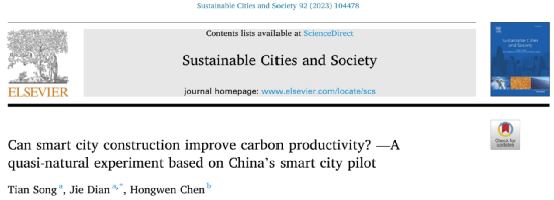
1. Research content
At present, China is faced with the dilemma of how to achieve the emission reduction target on the premise of ensuring economic growth. As a new type of urban development model, smart city construction may become the key to solving this problem. This paper conducts an empirical analysis using a multi-period difference-in-differences DID model, aiming to assess the impact of smart city pilot policies on carbon productivity. The research found that: (1) The construction of smart cities has increased the urban carbon productivity. Among them, the eastern and central cities have a significant promoting effect, while the western cities have a restraining effect. (2) The impact of smart city construction on carbon productivity has a time-lag effect. The pilot policy will take effect in the third year of implementation and reach the maximum in the fifth year. (3) Smart city construction can improve urban carbon productivity through technological progress, industrial structure upgrading, and energy structure optimization.
2. Model construction
Considering that the smart city pilot policy was implemented from 2012 to 2014, this study chooses 2007-2019 as the sample period, that is, the five years before and after the policy implementation. After preliminary screening, 230 prefecture-level cities were selected as research samples. Since the smart city pilot policy has been implemented in three batches, the multi-stage DID model is used for evaluation. The following econometric regression model was set up:

3. Analysis of empirical results
(1) Benchmark regression
The results obtained by using DID regression after controlling the city fixed effect and time fixed effect are shown in the table below. Among them, model (1) is the result of controlling only the key independent variables, and model (2) is the complete result of controlling all variables.
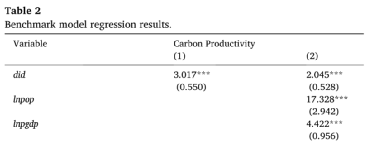
The results show that the estimated coefficient for the did variable is statistically significant at the 1% level . This suggests that the smart city pilot policy has indeed increased the city's carbon productivity. After adding additional control variables, the paper finds that lnpop makes sense, indicating that an increase in population size can increase carbon productivity. While population growth boosts carbon emissions, it can also lead to faster economic growth.
(2) Parallel trend test
The parallel trend test is the main principle of the multi-period DID model. That is, the changes in carbon productivity in pilot cities and non-pilot cities should be similar before implementing smart city pilot policies. The results of the parallel trend test carried out in this paper are as follows:
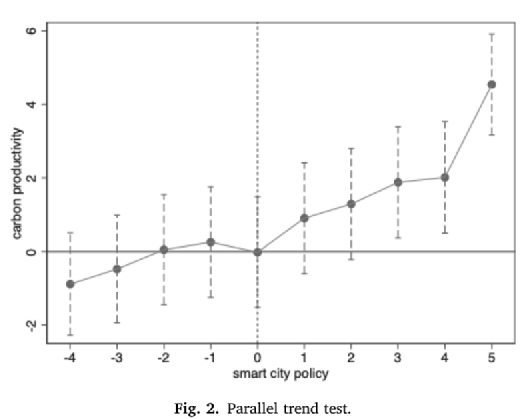

The results show that without launching the smart city pilot, there is no discernible difference between the two groups of cities, and that carbon productivity has increased steadily since the first year. In any case, the study sample varied considerably from the third year onwards, reaching a maximum in the fifth year. It can be shown that the impact of smart city pilot policies on carbon productivity is somewhat lagged and that this boosting effect becomes more pronounced over time.
(3) Robustness test
In order to exclude the interference of confounding factors from the research conclusions, a robustness test is also required. Therefore, this paper examines the estimated results of multiple dimensions, including the PSM-DID test, controlling for confounding policy effects, and placebo trials.
First, this paper draws on the propensity score matching method. According to the pairing results, the probability densities of the propensity scores of the treatment group and the control group were basically similar after pairing, indicating that the matching effect was better, as shown in Fig.3. Finally, the reliability of the results is tested by using the nearest neighbor matching estimation method.

1.PSM-DID test
The results are shown in Table 3 below, showing that the smart city pilot policies can still significantly increase carbon productivity after using the PSM-DID method. In addition, the initial samples are re-examined using radius matching and kernel density matching methods. It was found to be consistent with nearest neighbor matching results. Thus, it supports the empirical conclusions of the paper and demonstrates the large impact of smart city pilot policies on improving carbon productivity.
2. Controlling for intervention policy effects
In order to avoid the influence of other policies on carbon productivity during the sample period, resulting in deviations in baseline estimation results, this study collected and sorted out documents and identified two pilot policies that may affect carbon-promoted productivity during the sample period, namely, low-carbon city pilot policies and Innovation city pilot policy. Therefore, this paper adds two dichotomous variables: low-carbon city pilots and innovative city pilots. The obtained results are shown in Table 3 below.

3. Placebo trials
(1) Timing to promote smart city pilot policies.
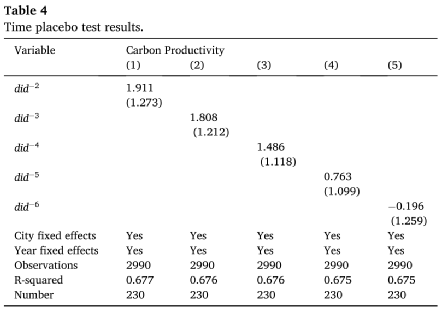
(2) Randomly select the treatment group and the control group.
After 1000 repeated treatments, 1000 regression coefficients and p-values are obtained. The kernel density distribution and p-values of these 1000 coefficient estimates are given. The estimated coefficients are mainly concentrated around zero and obey the normal distribution. Other policy or random factors that may affect the baseline estimation results of this study can be ruled out.
In this paper, two steps in two stages were used to test the mechanism. In the first stage, innovation performance was used as a mechanism variable to verify the impact of smart city pilot policies on technological progress, industrial structure upgrading, and energy structure optimization. In the second stage, by setting three mechanism variables of technological progress, industrial structure upgrading and energy structure optimization, the impact of smart city pilot policies on carbon productivity is verified. Build the following models respectively:
The results of the first stage are shown in Table 5 below, where column (1) is used to regress innovation performance, indicating that smart city pilot policies promote innovation. Columns (2)-(4) present the regression results of the three variables on innovation performance, indicating that innovation supports technological progress, industrial structure upgrading, and energy structure optimization.
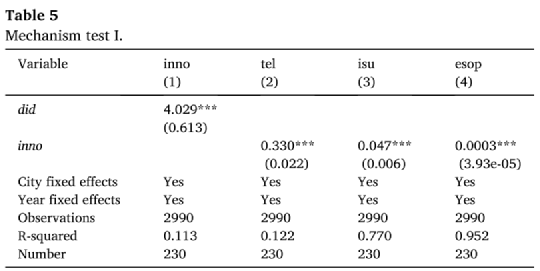

(1) Regional Heterogeneity of Cities
The sample cities are tested for heterogeneity according to the three regions of East, Central and West, while the three provinces of Northeast China, Liaoning, Jilin and Heilongjiang are divided into East for statistical purposes. The results are shown in Table 7 below, and the study shows that the smart city pilot policy has improved the carbon productivity of eastern and central cities. The improvement effect is more obvious in eastern cities. Instead, it has a significant dampening effect on carbon productivity in western cities.
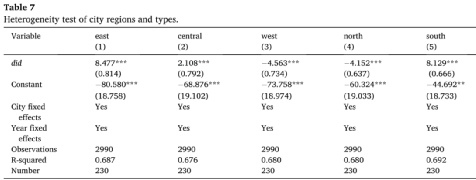
(2) Heterogeneity of city types

After the local government is approved as a smart city pilot, the corresponding carbon productivity improvement effect may have a specific impact. This paper uses "short-term" and "long-term" as policy variables to measure short-term and long-term policy effects. In order to test the short-term policy effect, the third year after the approval of the pilot cities is taken as the starting point. For the first two years of policy implementation, a value of 1 is used, and for other years a value of 0 is used. At the same time, take the smart city pilot policy in the third year and later as 1, and the first two years as 0 to test its long-term policy effect. Research shows that there is a lag in piloting policies for smart cities to boost carbon productivity. Policy effects are mainly reflected in the long run.
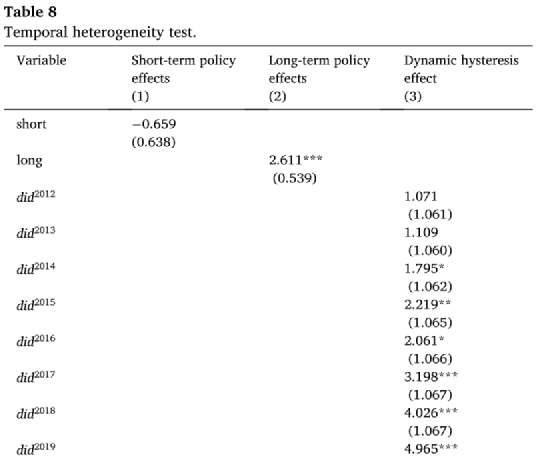
the data shows
1. Data source : self-organization
2. Time span : 2006-2019
3. Regional scope : prefecture-level cities
4. Indicator description : This article screens the samples according to the following principles:
① Some pilot cities only have districts approved as smart cities within their municipal districts Counties (such as Shunde District , Foshan City), instead of conducting smart city pilots in the entire city, in order to determine the net effect of smart city pilot policies, these cities are excluded in this paper;
, Guizhou, etc.) can be challenging to collect data, so the urban sample has more missing values, and such prefecture-level cities are also excluded.